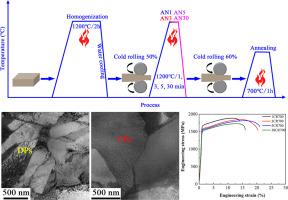Influence of persistent effects of initial microstructure on the evolution of microstructure and mechanical properties in CoCrFeNi-based high entropy alloys
IF 14.3
1区 材料科学
Q1 MATERIALS SCIENCE, MULTIDISCIPLINARY
引用次数: 0
Abstract
Thermomechanical processing is commonly employed to tailor the microstructure and enhance the mechanical properties of high entropy alloys (HEAs). However, the influence of the initial microstructure prior to deformation has received limited attention. In this study, we systematically investigate the influence of initial grain structure on microstructural evolution and mechanical performance in HEAs. Alloys with varying recrystallization degrees and initial grain sizes were fabricated. Results show that smaller initial grains promote finer recrystallized structures due to higher grain boundary density and stored energy. Notably, the recrystallized grain morphology exhibited strong persistence from the initial microstructure. Initial grain size also influenced precipitation behavior. Larger grains favored spherical precipitates and continuous precipitation, while smaller grains promoted lamellar precipitation. Tensile testing at room temperature revealed that the fully recrystallized alloy with the finest initial grains achieved the optimal strength-ductility combination, exhibiting a yield strength of 156732 MPa, an ultimate tensile strength of 184447 MPa, and a total elongation of (20.41.0)%. These findings highlight the pivotal role of initial microstructure in dictating recrystallization and precipitation pathways, offering a practical strategy for optimizing HEA performance through microstructural design.

初始组织持续效应对cocrfeni基高熵合金组织和力学性能演变的影响
热机械加工通常用于调整高熵合金(HEAs)的显微组织和提高其力学性能。然而,变形前的初始微观组织的影响得到了有限的关注。在本研究中,我们系统地研究了初始晶粒结构对HEAs微观组织演变和力学性能的影响。制备了不同再结晶程度和初始晶粒尺寸的合金。结果表明,晶粒越小,晶界密度越大,晶界蓄能越大,再结晶组织越细。值得注意的是,再结晶的晶粒形态与初始组织相比具有较强的持久性。初始晶粒尺寸也影响析出行为。晶粒较大有利于球形析出和连续析出,而晶粒较小有利于片层析出。室温拉伸试验结果表明,具有最细初始晶粒的完全再结晶合金获得了最佳的强度-塑性组合,屈服强度为1567±±32 MPa,极限抗拉强度为1844±±47 MPa,总伸长率为(20.4±±1.0)%。这些发现强调了初始微观结构在决定再结晶和沉淀路径中的关键作用,为通过微观结构设计优化HEA性能提供了实用的策略。
本文章由计算机程序翻译,如有差异,请以英文原文为准。
求助全文
约1分钟内获得全文
求助全文
来源期刊

Journal of Materials Science & Technology
工程技术-材料科学:综合
CiteScore
20.00
自引率
11.00%
发文量
995
审稿时长
13 days
期刊介绍:
Journal of Materials Science & Technology strives to promote global collaboration in the field of materials science and technology. It primarily publishes original research papers, invited review articles, letters, research notes, and summaries of scientific achievements. The journal covers a wide range of materials science and technology topics, including metallic materials, inorganic nonmetallic materials, and composite materials.
 求助内容:
求助内容: 应助结果提醒方式:
应助结果提醒方式:


